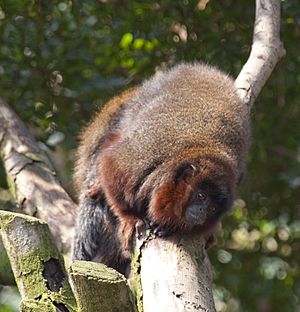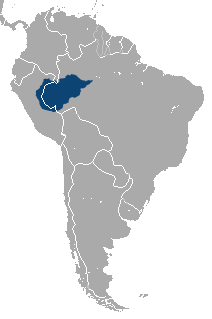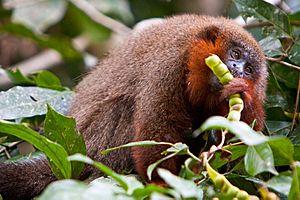Coppery titi monkey facts for kids
Quick facts for kids Coppery titi |
|
|---|---|
 |
|
| Coppery titi | |
| Conservation status | |
| Scientific classification | |
| Genus: |
Plecturocebus
|
| Species: |
cupreus
|
 |
|
| Coppery titi range | |
| Synonyms | |
|
|
The coppery titi monkey (Plecturocebus cupreus), also called the red titi monkey, is a type of titi monkey. These monkeys are a kind of New World monkey. They live in South America. You can find them in the Amazon areas of Brazil and Peru. They might also live in northern Bolivia. Scientists first described this monkey in 1823. Coppery titi monkeys can live for over 20 years. They eat fruits, insects, and plants. These monkeys live in pairs and have special ways to talk. They also protect themselves from animals that might hunt them.
Contents
Where Coppery Titis Live and What They Do
Coppery titi monkeys usually live in warm, wet forests. These forests are often found in low areas that flood sometimes. You can also find them in younger forests or near swamps. They like places with lots of bamboo too.
Most coppery titis live in Brazil, west of the Rio Madeira river. They are also found around the Rio Huallaga in Peru. Other groups live near the Rio Madre de Dios in Peru and Bolivia. You can also spot them near the northern Rio-Maranon-Amazonas area. Some live around the Eastern Cordillera in Peru and Ecuador. They are found between the Rios Guamues and Putumayo. And along the eastern base of the Sierra de la Macarena.
What Coppery Titis Eat
Coppery titis mostly eat fruit and insects. They spend about 75% of their time eating fruit. The rest of their diet includes bamboo, leaves, and some insects. Their favorite fruits are from Ficus trees and Brosimum rubecens plants. They also enjoy various berries.
They usually eat in the early morning and afternoon. They might snack on leaves before going to sleep. Coppery titis rarely eat with other types of monkeys. But they might eat in the same tree after another monkey leaves. Titi families often eat from the same food source together. This shows that meal times can be a social event for them.
Female monkeys change their diet when they are feeding babies. They eat almost twice as many insects then. This is because their bodies need more protein to make milk. Male monkeys do not change their diet when they are taking care of babies.
How Coppery Titis Behave
Coppery titi monkeys are active during the day. They spend all their time up in the trees. They live in family groups. Each group has an adult pair and their young. The adult pairs stay together for their whole lives. They are monogamous.
Family members often wrap their tails together. They do this before and during sleep. Their tails cannot grab things like some other monkeys' tails. When two titis meet for the first time, they smell each other's faces. They also rub their chests on branches. This spreads a special scent from a gland on their chest. Then they sniff the branch. This might help them mark their territory.
Coppery titis show how they feel with different body movements. When they are angry or excited, they might shake their heads and bodies. They also sway, look away, or raise their tails. Other signs include showing their teeth or arching their back.
Scientists have seen coppery titis using Psychotria leaves. They chew the plant and rub it on their bellies. This takes about five minutes. This behavior is rare. It is thought to be a way of self-medication. This plant is used in traditional medicine. It also has properties that fight viruses and bacteria.
Female monkeys will act like their partner towards other females. This shows how strong their bond is. If it works, the other female will leave. This helps the pair have babies successfully. When a baby is born, the parents' daily activities change. The mother eats more and rests less. The father eats less and rests more. This is because the mother needs more food to feed the baby. The father holds the baby more to protect it.
How Coppery Titis Talk and Communicate
Coppery titis are very noisy animals. They have many different calls and sounds. They make grunts, screams, whistles, and moans. Their most common calls are bellows, pumping sounds, and panting. These are the main parts of the male-female duets.
These duets happen every day. They sing at sunrise or just before. They sing near the edge of their territory. Nearby pairs will answer each other's duets. This helps them set their territory borders. Duets can last up to five minutes. They start with moaning and end with honking. During the duet, males and females take turns bellowing and panting. Between these parts, they make pumping sounds together.
The time between these synchronized sounds changes. New pairs take longer between sounds. Older pairs are more in sync. Weather also affects their singing. They sing longer on cloudy days than on clear ones. But they do not sing when it rains. Their calls can be heard up to one kilometer away. The calls have different sounds and pitches. This means you can tell individual monkeys apart by their voices. It is easier to identify adult monkeys than baby monkeys by their calls. This helps them identify their partner from far away.
Smelling is another way coppery titis communicate. When they are close, they smell each other's faces.
Coppery Titis in Nature and Their Safety
Coppery titis play an important role in their environment. They help spread the seeds of fruits they eat. This helps new plants grow in their habitat. Birds of prey and wild cats hunt coppery titis. Other possible hunters include ocelots, boas, and hawks.
People do not hunt coppery titis very often for food. This is unlike some other larger monkeys. But sometimes they are hunted for their meat and tails. Coppery titis live in remote areas. Because of this, the International Union for Conservation of Nature (IUCN) says they are of Least Concern. This means they are not currently in danger of disappearing.
How Coppery Titis Avoid Hunters
Coppery titis have a special way to scare off hunters. This is called "mobbing behavior." It starts when one male makes an alarm call. Other monkeys then join in. Within a few minutes, a group of monkeys is making loud calls around the hunter. The monkeys move around the hunter quickly. They keep making alarm calls, wagging their tails, and swaying their heads. They also get goose bumps during this. Scientists believe this behavior helps scare the hunter away. It also makes it less likely for the hunter to attack.
This "mobbing behavior" usually happens without baby monkeys. If there is a baby, the coppery titi will hide farther away. But they will still make alarm calls. The longest alarm call ever seen lasted over 40 minutes. When there is danger, the male usually makes the call. If there is a baby, the male protects it.
See also
 In Spanish: Tití cobrizo para niños
In Spanish: Tití cobrizo para niños



